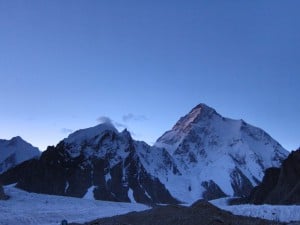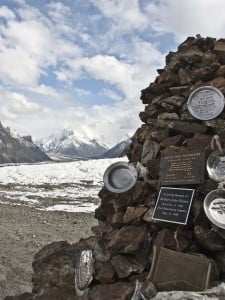
© John Roberts
“K2 is the most demanding climb in the Himalayas. 1 in 4 climbers who have tried to get to the top have perished.” James Naughtie, BBC Radio 4 Today Programme, 16th Nov 2011
If my mother was listening to Radio 4 this morning I’m fairly sure there’ll be no way she’ll ever allow me to leave for Pakistan with the objective of standing on the summit of K2. Little does she know of the rumblings that have been coming in and out of my inbox over the last few months. But is it really that dangerous? Is it really the “most demanding climb in the Himalaya?” Is there a 1 in 4 chance I might not come back or one of my climbing partners?
From the intro of the piece I was hoping Doug Scott, a beacon of British mountaineering would put them straight. Alas no, only Nazir Sabir, the first Pakistani to summit K2 mentioned that it was not the most dangerous, but possibly the most beautiful.
K2 (Chogori) sits in the North of Pakistan in the Karakoram, not the Himalaya. I can vouch for the fact that the weather here is savage and unpredictable but the rest of the hyperbole surrounding K2 does nobody a favour; climbers, mountaineers and the general public. Little do the general public already understand about mountaineering and expedition climbing; the choices, the reasons, the sufferings, the friendships, the successes and inevitably the deaths.
If we quantify “demanding” in terms of difficulty and danger then even Wikipedia refutes James Naughtie’s claim. The current entry reads:
The mountain is believed by many[who?] to be the world’s most difficult and dangerous climb, hence its nickname “the Savage Mountain.”
http://en.wikipedia.org/wiki/K2
It is certainly not the world’s most difficult climb. There are many routes to the summit including the Abruzzi Ridge and the Cesen Route, that with oxygen and a team of porters are ultimately very easy compared to some of the routes or styles established in the last few years.

The often controversial Piolet D’Or exists to reward outstanding mountaineering achievement. Many of the routes which have won in recent years are surely categorised above the standard routes on K2? Compare as a starter: Steve House and Vince Anderson on the Rupal Face of Nanga Parbat (nick-named the Killer mountain), alpine style, with no supplementary O2. The style of ascent and route choice element is something that the great majority of those outside (and some inside) the climbing world fail to see. The factors at play are much greater than just the height or the weather. I’d put Cory Richard’s, Denis Urubko and Simone Moro’s audacious winter ascent of Gasherbrum II, very high up there in the stakes of difficulty and danger.
So is K2 statistically the most dangerous? Even taking the quoted 1 in 4 deaths, its Himalayan neighbour Annapurna I tops it with a mighty 40% death rate (1 in 2.5).
However, 1 in 4 climbers have not perished trying to get to the top of K2, nor have 1 in 2.5 on Annapurna I. This ever quoted death rate is calculated from the number of recorded summits vs the number of deaths. This is a flawed statistic, but unfortunately it’s pretty much the best we can do which is why it should be used with clarity. Consider the unclimbed mountain whose single or multiple unsuccessful attempts have ended in a death. That gives the mountain an infinite danger factor, and there a number of peaks out there that hold that claim.
K2 has had a very great number of attempts, the vast majority of which have ended unsuccessfully below the summit and the vast majority of which have not ended in a fatality. There were over 20 attempts from the Pakistani side this year, all of whom survived and of course the successful 3 summits and descents from the Chinese side. That doesn’t sound like a peak that claims the lives of 1 in 4 climbers who set foot on it.
This all said, mountaineering is a risky activity, all mountaineers go to every peak accepting that we have to manage a certain level of risk both quantifiable and unmanageable, and K2 has claimed the lives of some of the great and good of our way of life, the tragedy in 2008 unluckily and disproportionately claiming eleven lives.

K2 is ultimately a mountain, which along with all the others, should be treated with respect. Unfortunately a lack of respect is what caused the only death I’ve actually witnessed on one of the big peaks.
Climbers sometimes get a bad name for putting themselves at risk. Some do risk themselves very disproportionately; some die foolishly and some die unluckily, the vast majority live to an old age rich with experiences. Mis-reporting and hyperbole does nothing for the lifestyle and does nothing for all climbers especially those at the very top of their game who achieve, often un-noticed, incredible feats of skill, endurance and guts.
You can listen again to the BBC radio piece here: http://news.bbc.co.uk/today/hi/today/newsid_9640000/9640886.stm